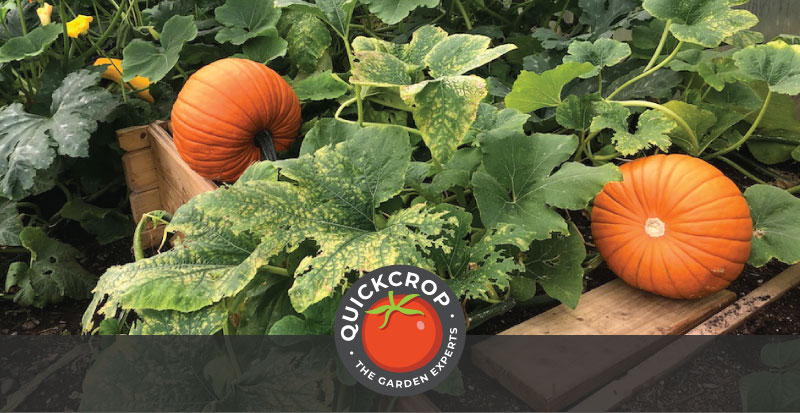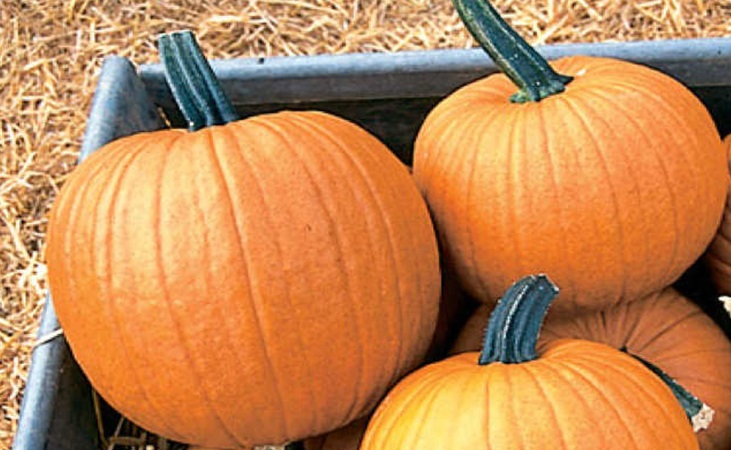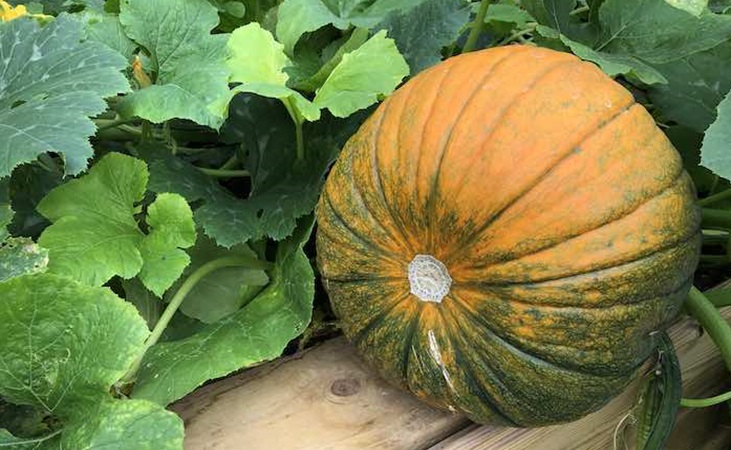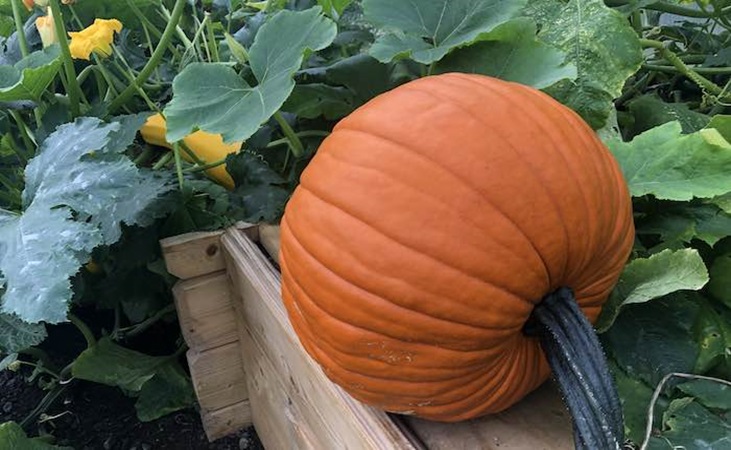How To Grow Pumpkins

Pumpkins have a special appeal for both adults and children, especially at Halloween. The carved pumpkin outside the front door - or being carried house to house as a lantern - is an established tradition with a simple and uncanny visual power (although if you want to go the truly authentic Samhain route we should point you to our turnip section).
But pumpkins are great nutritionally too. Who hasn't heard of pumpkin pie? Some of the pumpkins seeds are also edible and delicious when dry roasted with a sprinkling of salt.
Interestingly, it isn't just the fruit itself which can be eaten: the shoots and young leaves can be cooked, and the flowers are edible either raw or cooked.

Where to Grow Pumpkins
Pumpkins belong to the gourd family, which also includes marrows, courgettes and squashes. Most varieties grow very large and have trailing vines, along which the fruit grows.
Pumpkin plants are not hardy and need a lot of sunshine and a lot of water to stay healthy and produce a decent crop. For most families, one or two plants will be more than adequate.
Protection from high winds is also required. A sheltered warm spot is the best place to grow them. A fertile soil is essential, so ensure that you have added compost or well-rotted manure before planting or transplanting.

10ft Wide Polytunnel
View ProductAllow plenty of space for the vines to grow, or provide a trellis or plant support and train them along it as they grow. Some people also use twine to train the vines into spirals, which not only takes up less space, but also looks very pretty.
Recommended Pumpkin Varieties
Pumpkin Jack O'Lantern
These are traditional Halloween-friendly round pumpkins, with a bright orange outer flesh that is perfect for carving out spooky faces and popping a tea-light in. The carved out inner flesh is great for recipes in the kitchen too, from delicious homemade Pumpkin Pies to warming Curried Pumpkin Soup.
These pumpkins can weigh 18-24 lbs.

Pumpkin Jack O'Lantern
View Product
Pumpkin Hundredweight
This variety has been specially bred to produce super-sized pumpkins: one of the best varieties for competitions in other words, but they are also delicious to eat. The yellow/orange-skinned fruits will put on weight easily; pinch out all but one fruit to put all the plant's energies into creating an absolute unit of a pumpkin.
Pumpkin Rouge Vif d'Etampes
A large, flat and heavily ribbed pumpkin with bright orange skin, Rouge Vif d'Etampes is perfect for soups, pies and other dishes. The seeds can also be toasted and eaten.
This variety stores very well and is widely used for carving. A pumpkin can weigh over 10kg, enough to give your arm a workout!

Pumpkin 'Racer F1'
This is a heavy
mid-size pumpkin with deep ribs and a dark green handle. It's a very productive bush type which is early to mature - so a great option for short season growing.
When to Grow Pumpkins
If starting the seeds off in the greenhouse or cold frame, the seeds can be sown in 4-5 inch pots in April, then slowly hardened off during the end of May. If they are to be planted outside, it might be best to delay sowing until early May.
Sowing Pumpkins
Sow each seed into an individual pot (7.5cm) or large module filled with a multipurpose compost; sow seeds 1cm (½in) deep. Plant 1 plant every 2 metres, as they will need a lot of space! For the larger pumpkin varieties you should opt for a 10 inch pot.

Large Vitopod Heated Propagator Single or Double
View ProductGerminate at 20°C using a heated propagator or place on a warm and bright windowsill. Water the seedlings regularly.
Pumpkins tend to be deep-rooted, so to ensure the water actually reaches the roots, it is a common practice to plant an upside-down plastic bottle with the base cut off in the mound next to the plant (either when sowing the seed or transplanting the young plant). This then enables you to pour the water into the bottle and ensure it gets to the roots.
If you're sowing seeds directly outdoors, be aware that it can be more challenging (in the UK or Ireland that is) depending on what kind of year it is weather-wise. Wait until the soil has warmed up (cover the soil with fleece to help it along if necessary). The temperature should be consistently above 15°C. Needless to say, wait until after the last frost date (late May/early June).

Heavy Duty Garden Fleece Rolls 2m x 100m
View ProductGive the seeds plenty of space when sowing: 3 feet apart for bush varieties and 5 ft for trailing varieties. Sow 2 or 3 seeds per planting hole, and if more than one germinates remove the weaker one(s). Cover with a cloche or similar covering for the first couple of weeks after germination.
Some gardeners favour planting in mounded up soil or 'hills', which will improve drainage and draw in more warmth from the sun.
Transplanting Pumpkins
Harden off the seedlings before planting out at the beginning of June. Leave 6-10 ft (= 2-3 m) between plants depending on the variety.
- For each plant, dig a hole (45cm / 18in apart) in the bed to about 5cm / 2in deeper than the pot and water if conditions are at all dry.
- Ease the pumpkin plant out of the pot, keeping the root ball undisturbed as far as possible.
- Place it in the hole and fill around the plant with soil.

Pumpkin Crop Care
Pumpkins are fairly thirsty as they grow, especially once the fruit has started to ripen - so watering during prolonged dry periods is important. Once the plant has started fruiting, feed every couple of weeks with a high-potash tomato feed.
If you only require a few fruit, you can remove any surplus pumpkins growing early on - as well as pinching out the growing tips of the vines. This will ensure the strength goes to the fruit you have chosen to keep.
To help the pumpkins ripen evenly, remove any large leaves which are shading them and turn them very gently, ensuring you don't damage the stalk.
Pumpkin Pests and Diseases
Don't grow pumpkins near cucumbers, courgettes, marrows or squash, as these are all susceptible to cucumber mosaic virus. Keeping them well apart in the garden helps to prevent cross-infection.

50 Metre Soaker Hose
View ProductThe gourd family of crops is particularly susceptible to powdery mildew, which is a white fungus that forms on leaves. Try and avoid this by watering plants only during the day (which allows moisture to evaporate quickly) or by using drip irrigation or a soaker hose, which waters roots while not soaking the leaves.
It is also advisable to place some wood or matting under the fruit to keep it from getting too wet on the ground or being attacked by pests.
Outdoor sowings can be troubled by slugs and snails.

Harvesting Pumpkins - Tips
You can expect your pumpkins to be ready to harvest from anything between 12 to 20 weeks after sowing, depending on the variety. This is typically in early to mid October (which is very timely given the approaching season!). Be sure to pick them before the first frost arrives.
You will know when the pumpkin is ripe because the stem starts to crack and the outer skin gets harder. The colour should be a rich, dark orange. Another way of telling if a pumpkin is ripe is by giving it a thump! If it sounds hollow it is ready to pick.

Pumpkin Hundredweight
View ProductCut the 'handle' at the point it joins the main stem rather than at the fruit end; this way the pumpkin will keep for longer.
If you want to store your pumpkin, leave in the sun for another week or so if possible to give the skin time to harden further - this is called 'curing' the pumpkin. Uncured fruit will start to degrade faster, but a thick, tough skin will see your pumpkin through the winter and beyond.

Storing Pumpkins
Handle pumpkins carefully to avoid surface damage, which leads to decay and shortens shelf life. Remove pumpkins showing any signs of spoilage from storage shelves quickly.
For longer storage, freeze, can, or dry pumpkins for use in meals throughout the year.




